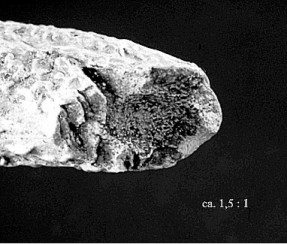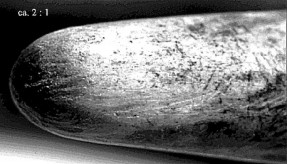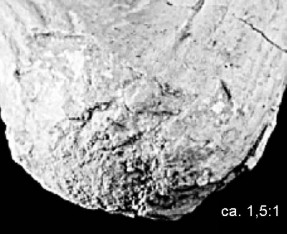
Fig. 33: Break in the distal part of a brow tine.
It is possible that antler fragments, which were not the result of deliberate tool production, were nevertheless used. Possible functional parts of antlers were, therefore, investigated for traces of use. The investigation was carried out under slanting light at 20x magnification. Potential functional zones along an antler include the base of the coronet, the skull fragments still attached to unshed antlers, the tips of all tines, the distal fractures of tine fragments, as well as the surfaces of the beams, especially those of the lower beams. Splintering, facetting, polishing and parallel scratches on potentially functional parts might point to intentional use. The Bilzingsleben material was then also compared with specimens used in experiments.
Surfaces of beams sometimes exhibit traces resulting from the activities of cervids while still carrying the antlers (Olsen 1989). However, traces caused by the movement of sandy sediments after burial are often scarcely distinguishable from traces of cervid activities. Various types of scratches occur on 86.9% of the Bilzingsleben antler finds. 23.3 % of them occur on one surface only, of which the majority (75%) were found lying with the scratched surfaces facing upwards. Although the scratches on 76.7% of the pieces are not restricted to one surface, these pieces cannot be described as showing all-round scratches since the scratches occur on just two sides - the lateral and the medial sides, of the antlers. 52% of the unifacially scratched surfaces are associated with unifacial abrasion.

Fig. 33: Break in the distal part of a brow tine.
Distal fractures of tines have previously been described as 'splintering' by Mania (1986b) and interpreted as evidence of use. This phenomenon (Fig. 33) can, however, be unambiguously identified as clean antler breaks and does not represent use. Tips of all tines (Table 7), as well as distal fractures of all tine fragments, whether separated from or still connected with beam elements, show almost no evidence of use.
| Cervid activities | Sediment impact or without any traces | Modern damage | Other / Hominid? | |
| Isolated tips of tines | 27.4% | 51.8% | 20.8% | - |
| Isolated tips of tines, terminally broken | 7.5% | 59.8% | 31.5% | 0.6% |
| isolated tips of brow, second and trez tines | 38.1% | 42.6% | 23.8% | - |
| Isolated tips of brow, second and trez tines, terminally broken | - | 62.5% | 37.5% | - |
| isolated crown tines | 32.7% | 47.3% | 20% | - |
| isolated crown tines, terminally broken | 15.4% | 53.8% | 26.9% | 3.8% |
| Tips of brow, second and trez tines, connected with main beam elements | 18.5% | 37% | 44.4% | - |
| Crown tines, connected with main beam elements | 13.8% | 44.8% | 41,4 % | - |
Four tine elements, however, form an exception, each of them with single or multiple scratches that intersect the edges of the distal fractures. Such traces could potentially result from a short period of hominid use, for example from digging in sandy soil (Fig. 34).

Fig. 34: Experimentally produced use marks (digging in sandy loam) along a tine tip.
Skull fragments attached to unshed antlers do not display any traces of hominid use. Moreover these skull fragments are almost exclusively broken along the medial, lateral and posterior sutures of the skull along which no traces of use or deliberate fracture are visible.
The coronets of shed antlers are almost entirely without traces of use and finds of this group show practically no signs of hack marks or facets. The damaged base of one coronet (Fig. 35), however, forms an exception as it is possible that it was used as an antler hammer, although during examination of this and other specimens at 20x magnification, no residual fragments of flint or other stone material were encountered.

Fig. 35: Possible use marks on a coronet.
© Internet Archaeology
URL: http://intarch.ac.uk/journal/issue8/vollbrecht/en/9.html
Last updated: Thu Aug 10 2000